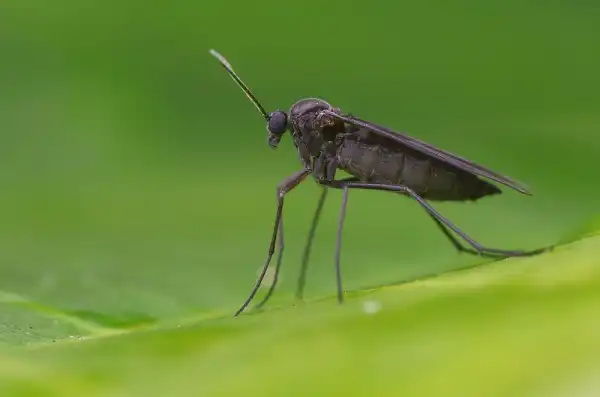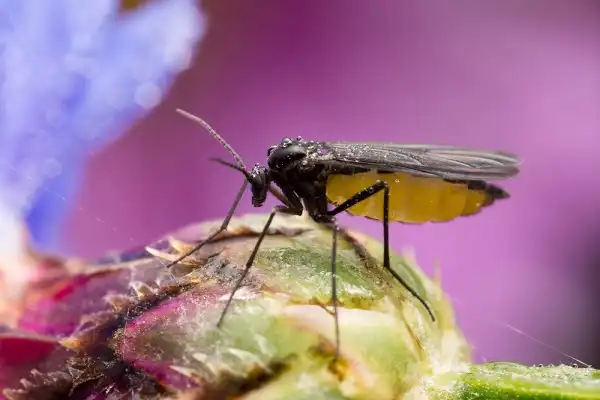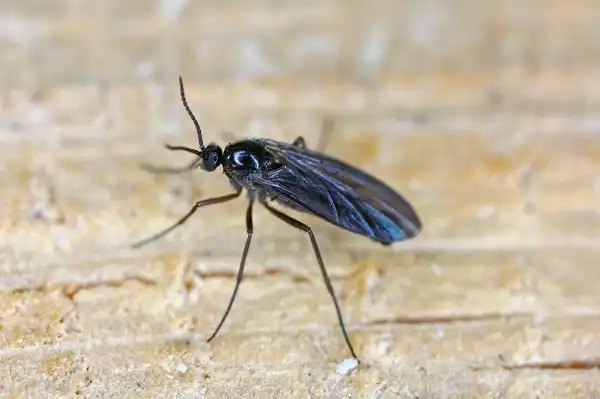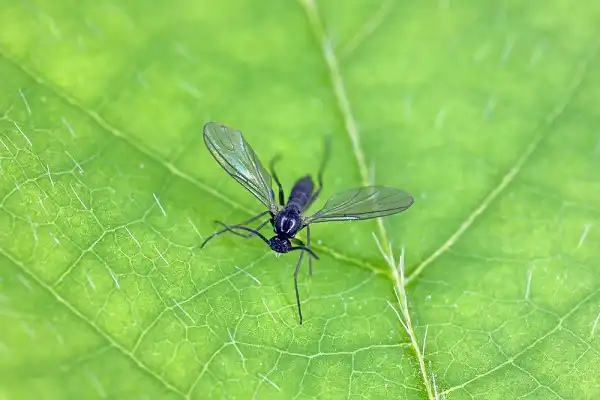Have you ever been outside and had the annoyance of tiny gnats buzzing around your face? Maybe you were gardening or enjoying a summer day, but these pesky bugs are everywhere. Gnats are often considered to be a nuisance pest due to their seemingly unstoppable ability to penetrate our daily lives with their whirring wings and constant presence. Let’s take a closer look at these small creatures’ lives, habits, and why they bother us so much.

Gnat Description
Gnats are tiny, winged insects. They can be recognized by their yellowish or brownish bodies with long antennae, and four wings. Their heads are usually transparent and composed of two black eyes. Although they have short lifespans, gnats reproduce quickly due to their high reproductive rate. These insects belong to the order Diptera, which means “two-winged” or “flies”. Gnats feed on sugary liquids such as nectar and honeydew, as well as decaying fruits and fungi. They also play an important role in pollination when they land on flowers to feed.
Gnat Habitat
Gnats have a wide variety of habitats, depending on the species. They are most commonly found in warm, moist environments near water sources. These include backyards, gardens, parks, and other outdoor areas with standing water or damp soil. Gnats are also attracted to over-watered plants and compost piles because the decaying matter provides them with a food source. Most gnat species prefer to live near areas with vegetation as this gives them access to food sources. Many species of gnat are also known to inhabit dark spaces such as caves and crevices where they can hide from predators.
Gnats usually lay their eggs in damp soil or near water sources such as ponds, streams, or creeks. The larvae then hatch after several days and feed on nearby vegetation or decaying matter until they reach adulthood. The presence of gnats can be an indicator of a healthy ecosystem because they play an important role in pollination when they land on flowers to feed. However, their high reproductivity rate means that an unchecked population can quickly get out of hand and become a nuisance pest.
Gnat Diet
Gnats feed on sugary liquids such as nectar and honeydew, as well as decaying fruits and fungi. They may also drink from damp soil or standing water sources. In addition to these items, they can also feed on pollen, spores, and small insects. Gnats are an important part of the pollination process due to their ability to carry pollen over large distances. This is because they land on flowers while they feed on nectar and honeydew, allowing them to pick up and transport the pollen from one flower to another and thus help with pollination. Because of their small size, gnats have a very fast metabolism which requires them to eat several times throughout the day in order to sustain themselves. This often leads them to swarm around food sources in large numbers. As such, it is important that any insecticide used for pest control purposes does not endanger beneficial insects such as gnats which provide important ecological services like pollination.

Gnat Size
Gnats are incredibly small insects, typically measuring between 1/8 and 1/16 of an inch in length. Although gnats may appear to be small and insignificant, they actually play an important role in the ecosystem due to their ability to pollinate plants. Because of their tiny nature, gnats can be easily disturbed by wind currents or other environmental factors such as temperature changes. This makes it difficult for them to cover large distances when pollinating plants or finding food sources. Additionally, because of their size, they can easily enter homes through open windows or doors if the environment is favorable for them.
Gnat Lifespan
Gnats have a short lifespan, typically ranging from a few weeks to a month. Female gnats lay eggs in damp soil or near water sources such as ponds, streams, or creeks. Once the eggs hatch, the larvae feed on nearby vegetation or decaying matter until they reach adulthood. At this point, their lifespans depend on the species and environmental conditions. For example, female midges can live for up to 2 weeks, while crane fly larvae can survive for several years underground before emerging as adults. In some cases, adult gnats may even have lifespans of up to 6 months. Gnats also have high reproductive rates due to their ability to lay hundreds of eggs at once and their short lifespans. This means that an unchecked population can quickly get out of hand and become a nuisance pest.
Gnat Behavior
Gnat behavior is largely determined by their environment. They typically fly around in search of food sources like nectar, honeydew, pollen, and small insects. Gnats are also highly attracted to over-watered plants and compost piles because of the decaying matter they provide as a food source. In addition to seeking out food sources, gnats engage in other activities to survive and reproduce. Adult gnats often swarm together in large numbers near water sources where they mate and lay eggs. Gnats are also important pollinators due to their ability to carry pollen over large distances via their wings when they land on flowers to feed on nectar and honeydew. In this way, they are an integral part of the pollination process for many species of plants and flowers around the world.

Gnat Speed
Gnats are incredibly fast insects, typically flying at speeds of up to 25 miles per hour. They have four wings which help them to maneuver quickly and efficiently around their environment. Their small size allows them to enter through even the tiniest of openings, making them difficult to contain or keep out of certain areas. Gnats can cover large distances in short periods of time due to their speed and agility. This is especially important for pollination as they are able to transport pollen from one flower to another quickly and over long distances. In addition, their fast metabolism requires them to eat several times throughout the day in order for them to sustain themselves, so speed is essential for finding food sources.
Gnat Reproduction
Gnat reproduction occurs quickly due to their short lifespans and high reproductive rate. Female gnats lay eggs in damp soil or near water sources such as ponds, streams, or creeks. Once the eggs hatch, the larvae feed on nearby vegetation or decaying matter until they reach adulthood. The number of eggs a female gnat can lay depends on the species. For example, female midges can lay up to 300 eggs at once while crane fly larvae can lay up to 500 eggs. These eggs hatch within a few days and the larvae feed for several weeks before reaching adulthood.
Gnat Hunting
Gnat hunting is a method of pest control that involves the use of traps, sprays, and other tools to capture and eliminate large populations of gnats. This can be done in both indoor and outdoor spaces and is one of the most effective ways to reduce the gnat population in an area. Traps are often used for gnat hunting, as they offer a safe and efficient way to catch large numbers of gnats in a relatively short amount of time. Traps come in many forms, including sticky traps which feature adhesive surfaces designed to trap insects.
These traps can be placed near food sources such as compost piles or over-watered plants. In addition to traps, insecticides can also be used for gnat hunting. Insecticides come in many forms and kill or repel insects when applied directly or indirectly through contact or ingestion. Insecticides may contain natural ingredients like pyrethrum or synthetic chemicals like permethrin which target specific species of insects while leaving beneficial ones unharmed.

Conclusion
Gnats, while often seen as a nuisance pest due to their high reproductive rate, are actually important pollinators and play an integral role in the maintenance of healthy ecosystems. Gnat hunting is one of the most effective methods for reducing gnat populations in an area. Traps and insecticides can be used for this purpose but caution should always be taken when using these tools. Additionally, any pest control measures used should not endanger beneficial insects like gnats which provide important ecological services like pollination.
Frequently Asked Question


